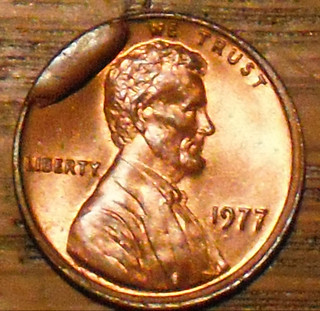
PREV ARTICLE
NEXT ARTICLE
FULL ISSUE
PREV FULL ISSUE
VOCABULARY TERM: CUDDick Johnson submitted this entry from his Encyclopedia of Coin and Medal Terminology. Thanks. I added some images. At left is a Lincoln cent with an obverse cud; at right is a die for a Malaysian coin showing a break that would cause a cud when struck. -Editor
  https://www.cointalk.com/threads/1977-cud-error-penny-value.198640/
Cud. A raised lump or boss on a struck piece near the rim. There are two kinds of cuds: (1) on the face of the struck piece, as the result of a diechip breaking away from the surface of the die at the edge leaving a cavity that forms such a boss on each piece struck from that die; and (2) on the edge, where it is a result of a broken collar. The latter is called a collar cud by collectors. (A raised lump elsewhere on the face away from the rim of a struck pieces called a boss.) In either case it takes the shape of the area broken away from the mass of the die. Cuds are the end result of a progression of events in the life of a die once it starts to deteriorate. It begins with a hairline crack at the point of greatest metal stress on the surface of a die. This is nearly always near the edge where steeped-pitched lettering, as legend, is located. Continued striking causes this hairline crack to grow. It widens and deepens into a diecrack. Two or more nearby diecracks may join. With even more striking these diecracks may turn into a diebreak. The portion of the die that is dislodged may not yet fall away immediately being a retained diechip or until continued striking causes it inevitably to fall away. At this point the portion of the die that is missing has created a cavity, die cavity. It is these cavities that create the cud on all pieces struck from that die forever after. It is a pressman's responsibility to halt and remove such broken dies during a production run. This is one reason pressmen continually inspect struck pieces with a magnifying glass. Any coin with a cud is reason to stop the press, to remove the impaired die, and to replace it with a fresh or satisfactory die. In cataloging, the existence and position of the cud should be noted. It is not necessary to explain the shape but the length of the cud could be mentioned. History of Cuds. The term cud was first used by Mort Goodman in his writings on mint errors in the 1960s. He first used the term "design cud." What was once a collector's term has now been accepted by the minting industry and the numismatic field for the type of mint error it describes. The concept is not that different from a cow's cud that is ruminated from one stomach to another. In coining the ruminated material is metal from the mass of the blank filling the cavity broken away from the edge of the die, or from the collar. See also broken die, collar break. Reference:
Looking for the meaning of a numismatic word, or the description of a term? Try the Newman Numismatic Portal's Numismatic Dictionary at: https://nnp.wustl.edu/library/dictionary Or if you would like a printed copy of the complete Encyclopedia, it is available. There are 1,854 terms, on 678 pages, in The Encyclopedia of Coin and Medal Technology. Even running two a week would require more than 19 years to publish them all. If you would like an advance draft of this vital reference work it may be obtained from the author for your check of $50 sent postpaid. Dick Johnson, 139 Thompson Drive, Torrington, CT 06790. THE BOOK BAZARRE
Wayne Homren, Editor The Numismatic Bibliomania Society is a non-profit organization promoting numismatic literature. See our web site at coinbooks.org. To submit items for publication in The E-Sylum, write to the Editor at this address: whomren@gmail.com To subscribe go to: https://my.binhost.com/lists/listinfo/esylum All Rights Reserved. NBS Home Page Contact the NBS webmaster 
|